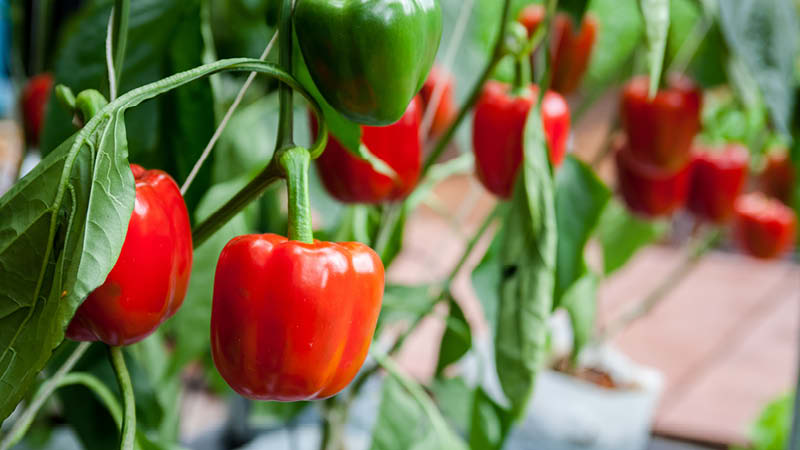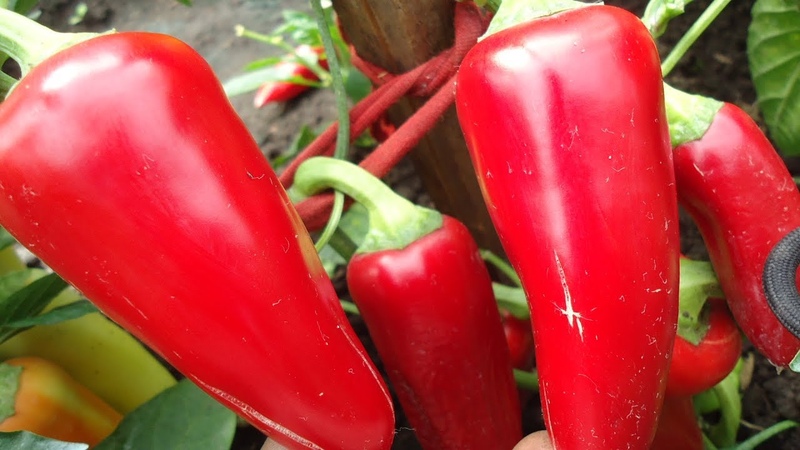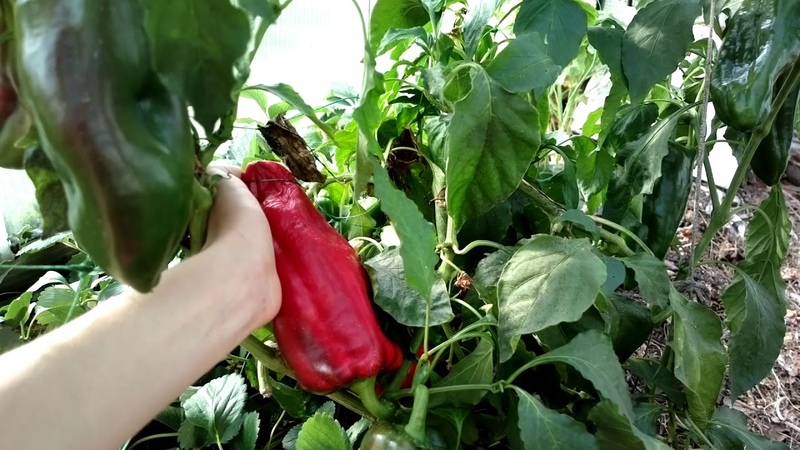The best hybrids and varieties of peppers for polycarbonate greenhouses
Pepper is a thermophilic culture. In regions with warm climates and long summers, it is planted in open beds, and in areas with unpredictable weather, they prefer to grow in polycarbonate greenhouses. Such structures have a special microclimate (it is always hot and humid there), which is why summer residents observe special agrotechnical rules.
Consider further what these rules are and which varieties and hybrids of pepper perform best in greenhouses.
The content of the article
The best varieties and hybrids of pepper for polycarbonate greenhouses
A polycarbonate greenhouse is a durable and safe structure for growing vegetables and fruits. The structure is easy to build yourself. It is resistant to external influences: wind, rain and fog.
Polycarbonate does not contain harmful and hazardous substances. Many varieties of peppers are grown in greenhouses, the most popular of which are discussed below.

Isabella f1
A mid-season hybrid ripens 110–120 days after planting. The plant is tall, spreading. Fruits are prismatic, deep red. The average weight of a vegetable is 150-200 g. The walls are dense, about 8 mm thick. The hybrid has good keeping quality and can be transported over long distances without any problems. The taste is juicy and sweet. The vegetable is versatile in use, excellent for preparing winter preparations, vitamin salads and side dishes.
To obtain a rich harvest, the hybrid is planted in seedlings. To do this, cleaned soil is poured into the container and disinfected seeds are placed in it. Disinfect planting material in a solution of potassium permanganate or succinic acid. Seedlings are grown on a sunny windowsill, watered once every 5-7 days. The hybrid is planted on a cloudy, windless day.
California miracle
The bushes are compact, reach a height of 80–90 cm. The harvest ripens in 115–120 days. Vegetables are cuboid, slightly flattened, bright red in color. Fruit weight varies from 70 to 130 g. The surface is glossy, the aroma is pronounced. The California miracle is used as a base for stuffed dishes.
The main advantages of the variety include:
- attractive appearance;
- unpretentious care;
- sweet and juicy taste;
- versatility in application;
- resistance to major diseases and pests of culture.
Cockatoo f1
The crop ripens within 100-110 days from the moment of planting. The hybrid received an interesting name for its external similarity to the beak of a bird. Cylindrical, elongated and thin fruits reach a length of 30-40 cm. The flesh is firm and fibrous, the taste is sweet and crunchy. Fruit weight varies from 350 to 500 g. The walls are dense, up to 1 cm in thickness.
The yield is average - from 1 m2 summer residents collect about 2-3 kg of original and tasty fruits.
Interesting! 100 g of bell pepper contains only 20 kcal. Vegetables are used to prepare healthy and dietary food. Pepper is rich in vitamins A and B, iron, magnesium and calcium. Eating the product in moderation increases immunity and activates digestion.
Vanguard
A mid-season fruitful variety ripens in 115–120 days. It is planted with both seedlings and seeds. Standard plant, tall. To prevent the stem from breaking under the weight of the fruit, the bush is tied up. The fruits are large, cuboid. The color is rich scarlet, the aroma is pleasant.
The taste is excellent, the pulp has a high sugar content. The surface is slightly ribbed.Pepper weight - about 300 g, wall thickness - 7 mm. The yield is high - about 8 kg of fruits are harvested from 1 m2. The taste of Avangard pepper is harmoniously combined with fresh herbs, vegetables, meat and fish dishes.
Hercules
Hercules belongs to early maturing varieties, the harvest is harvested in 90-100 days. The variety is popular because it is grown not only for personal consumption, but also for sale. Taste and commercial qualities are at the height: the fruits are even and large, the weight of one is about 250 g, the color is red. The wall thickness is about 8 mm.
When stored properly, vegetables retain their firmness and flavor until winter. The Hercules variety is perfect for making pickled and pickled pieces.
Agapovsky
Miniature bushes of the Agapovsky variety will decorate any garden. The crop ripens in 95-105 days. Fruits are thick-walled, prismatic. The surface is slightly ribbed, glossy, color is classic red. The weight of the pepper is 100-120 g, the pulp is fleshy and dense. The yield is high - about 10 kg of juicy fruits are harvested from 1 m2.
The main advantages of the Agapovsky variety gardeners include:
- early maturity;
- sweet taste;
- versatility;
- high productivity.
Tenderness
Early ripe variety Tenderness bears fruit in 90-100 days. Semi-spreading bushes, compact. The fruits are smooth and glossy, the weight of one varies from 70 to 110 g. The pulp is fibrous and sweet, there are few seeds. The density of the walls is up to 7 mm, the crop is perfectly stored in a dry basement and cellar.
Variety Tenderness is resistant to powdery mildew, root rot, late blight.
Important! When grown in a greenhouse, it is necessary to regularly ventilate the structure by opening doors or vents. If this is not done, the risk of developing dangerous diseases increases. Moisturize vegetables in moderation, it is important not to allow excess water. Sprinkle pepper in the early morning or evening to avoid sunburn. A stream of liquid is directed under the root, bypassing the stem and leaves.
Gogoshary
A semi-spreading standard plant reaches a height of 50 cm. The foliage is dense, dark green. Gogoshary variety has an interesting appearance: it resembles small round cherry tomatoes. Fruit weight - about 80 g, the surface is slightly ribbed. Depending on the subspecies, the pepper can be red, yellow and even purple. The pulp is fleshy and sweet, not bitter.
Despite its advantages, the Gogoshary variety has a number of significant disadvantages: it does not tolerate drought and sudden changes in the weather, it has an average immunity to diseases and pests. Pepper stems are fragile and brittle.
Atlant
Atlant belongs to mid-season and unpretentious varieties of care. Even a novice gardener will be able to grow a rich harvest. Fruit weight - from 200 to 400 g, wall density - 5–7 mm. The shape is elongated, prismatic. The surface is smooth, deep red color. The vegetable tastes sweet. The pulp is fleshy and crunchy, with a lot of seeds. The aroma is pleasant, fresh.
Health
The Zdorovye variety is grown mainly in central Russia. The pepper is early ripe, ripens in 80–90 days. The fruits are small, the average weight is 50 g. The wall thickness is only about 5 mm, therefore it is recommended to consume or process the Health pepper as soon as possible after harvest.
The taste is excellent, the pulp is fleshy and juicy. The variety got its name for its high content of nutrients: vitamins A and C, group B, fiber, calcium and magnesium. With regular use, the vegetable strengthens the immune system, normalizes digestion.
Belladonna f1
Grow a hybrid in glass and film greenhouses... Belladonna is resistant to disease and insect pests. Bushes are small, up to 80 cm in height. The color of the fruit is light yellow, the vegetable has high commercial qualities. The weight of the pepper is about 110 g. The surface is glossy, the wall thickness is up to 7 mm.
Belladonna looks great on the dining table as a fresh cut.
How to choose a variety
How to choose the right greenhouse pepper variety? First of all, attention is paid to the growing region. Some varieties and hybrids show excellent yields only in southern and fertile lands, while others are cold-resistant and suitable for cultivation in the Urals and Siberia.
When choosing, the properties of the vegetable are also taken into account: its yield, care requirements, taste.

Depending on the region
The varieties Atlant, Avangard and Hercules are suitable for growing in central Russia. They are resistant to diseases, but demanding on the composition of the soil. For Moscow and the Moscow region, they choose pepper Tenderness or the California miracle.
The varieties can show the best result only in long and warm summer conditions. Hybrids Kakadu and Isabella are suitable for growing in the Urals and Siberia. Vegetables are resistant to sudden changes in climate, immune to soil composition.
Depending on properties
If, when growing pepper, a good return of the crop is in the first place, choose the high-yielding varieties Avangard or Agapovsky. Their fruits are used for processing (harvested for the winter in the form of canned or pickled dishes, frozen) and consumed fresh. If it is more important to harvest the crop as soon as possible, choose early-ripening peppers Health or Tenderness. Fruits are harvested from them in early to mid-August.
Novice gardeners are advised to pay attention to compact bushes with light fruits, for example, Gogoshary or Tenderness. They do not require special care; it is enough to organize regular feeding with mineral and organic substances.
Read also:
What is good about the "Ogonyok" pepper variety and how to grow it properly at home.
Large and sweet variety of Big Girl pepper.
The harm and benefits of chili pepper for the body, the rate of its use.
Reviews

To find out which varieties of peppers for polycarbonate greenhouses are the most popular, we will study several reviews of experienced gardeners.
Evgeniy, Moscow: “The sweetest variety is Hercules. I always plant seedlings, after hardening the seedlings on the balcony. In care, everything is simple: I water the beds in the morning 1 time per week and fertilize with liquid manure 2-3 times per season. The yield is excellent, I collect up to 5 kg from one bush. "
Maria, Ufa: “I planted Kakadu pepper last year. The seed producer promised original fruits, but I have grown regular stretched vegetables. I followed all the rules in leaving, I don’t know what is the reason ”.
Olga, Tyumen: “I love peppers. Tenderness and Health. I love their taste and sweet aroma. I collect in mid-August, prepare salads for the winter and stuffed dishes from them. It turns out very tasty and healthy ”.
Conclusion
For planting in a greenhouse or greenhouses, unpretentious varieties and hybrids of pepper are suitable. The choice depends on several factors: the place of cultivation, the purpose of the fruit, the yield. Favorite taste - Gogoshary, Tenderness and Agapovsky; the leaders in yield are Hercules, Atlant and Isabella f1.
In the process of growing, it is important to regularly ventilate the structure, organize feeding in a timely manner and loosen the beds. Harvest after the vegetables have a firm and firm skin, rich color and sweet aroma. Bell pepper is used to make vitamin and delicious snacks, salads and side dishes.